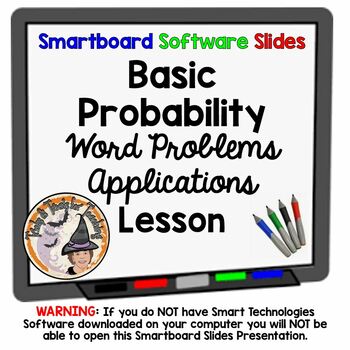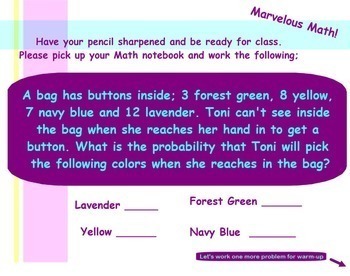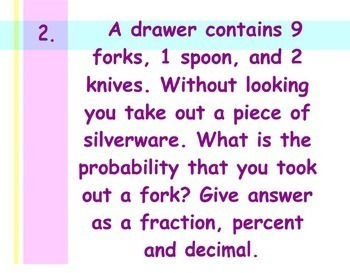Basic Probability Smartboard Slides Lesson Word Problems Applications
Tricks and Treats for Teaching
733 Followers
Grade Levels
6th - 8th, Staff
Subjects
Resource Type
Standards
CCSS6.SP.B.5
CCSS6.SP.B.5a
CCSS6.SP.B.5b
CCSS7.SP.C.5
CCSS7.SP.C.6
Formats Included
- NOTEBOOK (SMARTboard) File
Pages
24 pages
Tricks and Treats for Teaching
733 Followers
Description
This is a FABULOUS Smartboard-Lesson (24 slides total) for Applications-of Basic-Probability. This can be used as Math on the Move, Task Cards, Math Station, etc. TERRIFIC Basic Probability Word Problems. Everything you need to teach basic probability to your math class. Your students and you will both LOVE this! You'll enjoy using it year after year!
WARNING:
You MUST have SMART Technologies SMART software, and a SMARTBOARD to teach from, to effectively download, open and use this Interactive Smartboard Lesson. Go to https://legacy.smarttech.com/en/products/education-software/smart-learning-suite/download/trial to download a free trial.
Please be sure to L@@K at my 1,285+ TERRIFIC teaching resources.
~ ~ THANK YOU KINDLY ~ ~
Total Pages
24 pages
Answer Key
Included
Teaching Duration
N/A
Report this resource to TPT
Reported resources will be reviewed by our team. Report this resource to let us know if this resource violates TPT’s content guidelines.
Standards
to see state-specific standards (only available in the US).
CCSS6.SP.B.5
Summarize numerical data sets in relation to their context, such as by:
CCSS6.SP.B.5a
Reporting the number of observations.
CCSS6.SP.B.5b
Describing the nature of the attribute under investigation, including how it was measured and its units of measurement.
CCSS7.SP.C.5
Understand that the probability of a chance event is a number between 0 and 1 that expresses the likelihood of the event occurring. Larger numbers indicate greater likelihood. A probability near 0 indicates an unlikely event, a probability around 1/2 indicates an event that is neither unlikely nor likely, and a probability near 1 indicates a likely event.
CCSS7.SP.C.6
Approximate the probability of a chance event by collecting data on the chance process that produces it and observing its long-run relative frequency, and predict the approximate relative frequency given the probability. For example, when rolling a number cube 600 times, predict that a 3 or 6 would be rolled roughly 200 times, but probably not exactly 200 times.





